In Part I of this study, we considered several attempts to determine the order and times that various lifeboats were launched from the sinking Titanic. It was noted that the first attempt to establish some form of timeline was by the British Wreck Commission when they wrote their report on the loss of the SS Titanic back in 1912. It was also pointed out that they had a very short time to develop their conclusions with the limited evidence and resources available to them. They also admitted that their results should not be taken as very reliable.
We then considered two relatively modern-day studies that have attempted to look deeper into lifeboat launch times, the people involved, and the actions that took place during the evacuation process. In particular, we looked at the detailed work of Bill Wormstedt, Tad Fitch and George Behe (W-F-B), who published their groundbreaking results in an article, Titanic: The Lifeboat Launching Sequence Re-Examined86, and the lesser-known work of Ioannis Georgiou who published a comprehensive nine-part series of articles over several years entitled, The Lifeboat Story.87
As I stated in Part I, my objective was to review some of the differences between these works and point out a few things the authors may have overlooked, misinterpreted, or perhaps not fully considered. It was not, nor is it, my intent to repeat all the comprehensive work done by others on this subject but to work off of their work and offer some additional considerations and possible insights.
Another objective of this overall work is to try and quantify the angle of list and the angle of trim that Titanic took on as a function of time and see how the launch times of the boats, as developed in this work, fit in with that work. As also stated in Part I, the results of any such study are only as good as the reliability of the data that goes into it and the assumptions made. Therefore, the reader is cautioned not to assume that this, or any other such work that deals with this complex subject, should be taken as the last word.
A Revised Lifeboat Launch Time Sequence
Based on the information referenced in the W-F-B study, the Georgiou study, and in a number of arguments and evidence presented in Part I of this article, a revised table of a lifeboat launch times and related events were created. This is shown in the table below:
| Lifeboat Launch Times and Related Events | ||
|---|---|---|
| Time | Port side | Starboard side |
| 11:40pm | Impact with iceberg along starboard side. | |
| 11:50pm | 5° starboard list seen on inclinometer in wheelhouse. | |
| 12:27am | First CQD sent out by wireless. | |
| 12:40am | Boat #7 launched. | |
| 12:45am | Boat #5 launched | |
| 12:47am | First distress rocket fired by 4/O Boxhall. | |
| 12:55am | Boat #6 launched. | Boat #3 launched. |
| 1:05am | Boat #8 launched. | Boat #1 launched. |
| 1:15am | Boat #9 launched. | |
| 1:20am | Boat #16 launched. | |
| 1:25am | Boat #12 launched. | Boat #11 launched. |
| 1:30am | Boat #14 launched. | Boat #13 launched. |
| 1:33am | Boat #15 launched. | |
| 1:45am | Boat #2 launched. | |
| 1:50am | Boat #10 launched. | |
| 1:52am | Last distress rocket fired by QM Rowe. | |
| 1:55am | Boat #4 launched. | |
| 2:00am | Boat #C launched. | |
| 2:05am | Boat #D launched. | |
| 2:10am | W/Os Bride & Phillips abandon wireless cabin. | |
| 2:17am | Hull breaks, and lights go out. Boats B & A washed off. | |
| 2:20am | Ship disappears beneath Atlantic. | |
Explanation of Timing
What is the basis for the timing shown in the above table? It is well accepted that Titanic struck an iceberg at 11:40pm (our first listed event), and according to the evidence of QM Robert Hichens, the ship took on a 5° list to starboard (our second event) within the first five to ten minutes following the impact with the iceberg as seen on an inclinometer in the wheelhouse. This is depicted in the cross-sectional view in Figure 14 below.
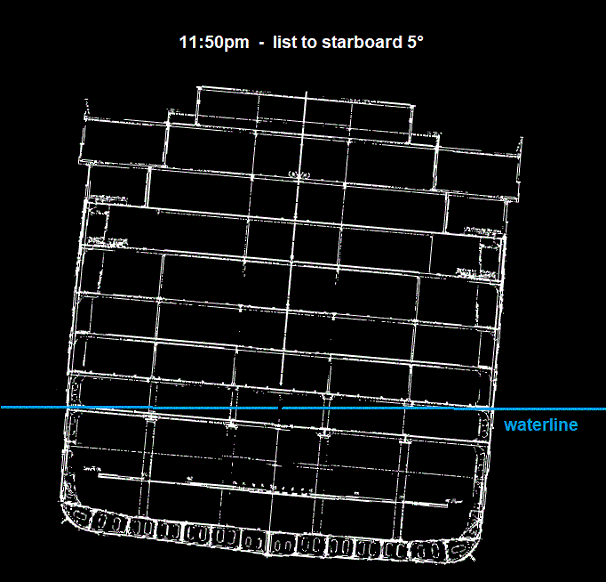
The next event in our table is the transmission of the first wireless distress message at 12:27am Titanic time. This was based on the reports from a number of wireless stations that the first CQD signal received from Titanic came at 10:25pm New York time, and we know that Titanic’s clocks were keeping Apparent time for April 14th that was 2 hours and 2 minutes ahead of clocks in New York.88
The next event in the timeline is the launching of lifeboat No. 7 from the starboard side at 12:40am. The timing for this event was well explained in the W-F-B and Georgiou articles, and it is quite unnecessary to repeat all the arguments here.
Following the launching of boat No. 7 came the launching of boat No. 5, shown here as occurring at 12:45am. This is tied to the sending up of the first socket distress signal at 12:47am; a time that was derived primarily on the timing of QM George Rowe’s call to the navigating bridge to inform them that he sighted a boat in the water and Fourth Officer Boxhall’s response to this call about a minute after he fired off a distress socket signal. As explained in Part I, Rowe’s call came about 25 minutes after the planned midnight change of watch was to have taken place, which was scheduled (as we know from QM Hichens) for 12:23am in Apparent time for April 14. Because of the accident, and unknown to George Rowe, who was stationed out on the poop deck, Titanic’s clocks were not put back that night. Converting Rowe’s partially adjusted time to unadjusted Titanic time for April 14, we find that Rowe’s call to the bridge came around 12:48am, and we took the time that Boxhall sent up that distress socket signal as one minute before, or 12:47am, because the call from Rowe came as Boxhall was putting the firing lanyard back in the wheelhouse. (This is the same time and reasoning used in the W-F-B sequence.) According to a number of eyewitnesses, lifeboat No. 5 was in the process of being lowered at the time that the first distress signal was fired. Thus, a launch time for boat No. 5 at 12:45am seems most reasonable, as it would take about 5 to 6 minutes to lower the boat to the sea, and 12:47am for the first socket signal firing would put the firing at a time when boat No. 5 was in the process of being lowered.
As for the launch times for boats No. 3 and No. 1, we have taken them to be the same as shown in the W-F-B sequence. The time intervals between the launchings of boats No. 5 and 3, and 3 and 1, were based mostly on the reported actions of those involved in the loading and launching of those boats. Those actions have been well documented in both the W-F-B and Georgiou articles. Based on those reported actions, about 10 minutes between the launchings of those boats seem to be about right. Thus with No. 5 being launched at 12:45am, we have No. 3 being let down at about 12:55am, and No. 1 being let down at about 1:05am.
It should also be noted that Lookout George Symons was working to clear these forward starboard boats along with Quartermaster Walter Wynn. According to Symons, after getting boats No. 7, 5 and 3 swung out, he and QM Wynn went down to B deck to clear away one of the guy wires used to support the emergency cutter lifeboat No. 1. When Symons came back up to the boat deck he assisted in getting passengers into boats No. 5 and No. 3.89 Wynn, on the other hand, apparently went down to the quartermaster’s quarters on E deck to get a knife and his kit bag.90 When he came back up, he was ordered to take charge of boat No. 9 by Sixth Officer James Moody, and that is the boat that he put his kit bag in as witnessed by Steward William Ward.
Over on the port side, we show No. 6 being lowered at 12:55am, and No. 8 being lowered at 1:05am. As explained in Part I, the primary basis for No. 6 being first lowered at 12:55am comes from the actions reported by QM Robert Hichens, which was also described in the W-F-B article. As previously explained, Hichens was relieved at the wheel when QM Perkis came by at 12:23am in unadjusted April 14th hours as expected. Hichens and Perkis were then told that they were no longer needed at the wheel, and Hichens went to uncover collapsible boat D on the port side. He spent about 10 to 15 minutes taking the cover and grips off the boat when Second Officer Lightoller came by and told him to go to boat No. 6 and start loading it with women and children. The time that this occurred was about 12:40am, a time that was also cited in the W-F-B article. Hichens testified that he spent about 15 to 20 minutes working to load boat No. 6 when he was sent away in the boat by Lightoller. This puts the launch time for No. 6 between 12:55am and 1:00am. According to Lookout Frederick Fleet, who had shipped the rudder and helped to load boat No. 6 along with Hichens and Lightoller, the boat got into the water around 1 o’clock. Fleet also testified that it was the first boat to be let down from the port side with people in it. Based on these actions, a launch time for boat No. 6 of 12:55am appears to be about right and is supported by first-hand, primary-source evidence.
As for boat No. 8, we know from Fleet that it too was being prepared more or less during the same time that No. 6 was being prepared. We also know from Lightoller that he left the final loading and launching of boat No. 8 to Chief Officer Wilde. If what Lightoller wrote in his 1935 book was accurate, Wilde allegedly came over from the starboard side soon after Lightoller allowed Major Peuchen to climb down into boat No. 6. As mentioned in Part I, according to what Lightoller wrote in 1935, Wilde came over to ask Lightoller about the location of the firearms, which were then distributed to Captain Smith and all three senior officers. According to Lightoller, this took all of 3 minutes time. After the distribution of firearms, the officers went back to working on the boats. If this story is true, then that would explain Wilde’s appearance on the forward port side of the boat deck at that time and his appearance by boat No. 8, which he helped load up and then launch with the assistance of Captain Smith.
We also know from Steward Alfred Crawford, who came over to No. 8 after seeing boat No. 5 lowered to the water on the starboard side, that boat No. 8 was launched sometime “after 1 o’clock,” and that time is supported by others as previously discussed in Part I. We also know from AB Thomas Jones, who was put in charge of boat No. 8, that there were only two other boats left on the forward port side after his boat, No. 8, was launched and that those two boats had to be boats No. 2 and No. 4 because they were not loaded up until much later on in the evacuation process. Furthermore, there was that group of women that showed up at No. 8 just as it was being lowered and were sent aft toward boat No. 10 by Chief Officer Wilde, as explained by Steward Crawford. Based on these and several other arguments that were presented in Part I, a launch time of 1:05am was assigned in this study for lifeboat No. 8.
The next boat to be launched in this sequence is boat No. 9 on the starboard side. As discussed quite extensively in Part I, swinging out and lowering No. 9 to the level of the deck started about the same time that boat No. 7 was lowered, around 12:40am. From the observations and actions described by a number of eyewitness, including stewards Joseph Wheat, William Ward, Frederick Ray, Charles Mackay, and James Widgery, as well as QM Water Wynn and Boson’s Mate Albert Haines, the loading of boat No. 9 with passengers must have started sometime close to 1 o’clock. We also know from these first-hand eyewitness accounts that boat No. 9 was loaded and launched from the boat deck and that by the time it reached the water, Titanic was noticeably down by the head by a few degrees but was not carrying any perceivable list. Based on these accounts, as described and presented in detail in Part I, a launch time close to 1:15am was chosen for boat No. 9 in this work.
During the loading of boat No. 9 an order was given to start loading the remaining lifeboats on the aft starboard side from A deck, something that would not have taken place if Titanic was still carrying a perceivable list to starboard. We also know from Steward Ward that when boat No. 9 reached the water (which would be about 1:20am in this timeline), boat No. 11 was still in the process of being loaded from A deck high above and that No. 9 could not immediately pull away from the ship because the boat oars were all lashed together and they first had to find a knife to cut the lashings away before the oars could be distributed. Based on what we were told about No. 11 still being in the process of loading after No. 9 reached the water, plus the slight difficulty in getting No. 9 to pull away, we have assigned a launch time for boat No. 11 of 1:25am, just 10 minutes after the launch time for boat No. 9.
As for boat No. 13, we were told by Steward Charles Mackay that No. 13 started down just as No. 11 reached the water’s edge. Assuming it took about 5 to 6 minutes to lower No. 13 from A deck (about 50 feet above the water at that location), that gave us a launch time for boat No. 13 of around 1:30am.
As for boat No. 15, we were told by Leading Fireman Frederick Barrett, who assumed command of boat No. 13, that No. 15 started down about “30 seconds” after No. 13, and that it nearly came on top of No. 13, which had drifted under the place where No. 15 was headed for because of the wash from the ship’s starboard-side circulating pump discharge. However, given the difficulty in freeing the falls, which had to be cut by a knife at both ends of the boat, as well as having to keep the boat off the ship’s side using the oars as revealed by eyewitnesses, it seems that Barrett’s 30 seconds might be somewhat underestimated. In this work, we have assumed that boat No. 15 started down about 2 to 3 minutes after boat No. 13 started down, thus a launch time of 1:33am for boat No. 15.
The reader may be interested in reading the little story written by second-class passenger Lawrence Beesley about this rumor of men going to the port side and women going to the starboard side that we only touched upon briefly in Part I. It is taken directly from Beesley’s 1912 book, The Loss of the SS Titanic, in the chapter that dealt with the embarkation of passengers in lifeboats:
“Almost immediately after this incident [where some women were told to go down to A deck to get into the aft starboard boats], a report went round among men on the top deck – the starboard side – that men were to be taken off on the port side; how it originated, I am quite unable to say, but can only suppose that as the port boats, numbers 10 to 16, were not lowered from the top deck quite so soon as the starboard boats (they could still be seen on deck), it might be assumed that women were being taken off on one side and men on the other; but in whatever way the report started, it was acted on at once by almost all the men, who crowded across to the port side and watched the preparation for lowering the boats, leaving the starboard side almost deserted.”
We know from several eyewitnesses that women had to be brought over from the port side to the starboard side during the final loading of boat No. 9 and that a number of stewards, including Joseph Wheat, were ordered by Murdoch to gather women and start loading the aftermost starboard boats from A deck while No. 9 was still being loaded up. From Beesley’s observation, it is clear that all of the aft port-side boats (he even cited them by their numbers—10 through 16) “could still be seen on deck” after the aftermost starboard boats had been lowered down to A-deck for loading.
We know that crowds had gathered around the aftermost port-side boats early on and that Chief Officer Wilde was seen by Steward Crawford going aft toward those boats after he ordered the lowering of lifeboat No. 8. We also know that Wilde was seen by No. 14 when that boat was being loaded with women and children. We also know that Lightoller went aft at one point, probably after leaving Wilde to finish the loading and launching of boat No. 8, and was seen at boat No. 12, which he helped to load with women and children. We also know that Sixth Officer Moody had shown up at No. 16 after coming over from working on No. 9 to finish the loading and launching of boat No. 16. (Moody was seen by Steward Frederick Ray as they were swinging out No. 9, and seen by QM Walter Wynn when Moody ordered him to take charge of No. 9 and start loading it soon after it had been swung out and lowered to the level of the deck.) We also know that Fifth Officer Harold Lowe came over and found Moody at boat No. 16 on the port side after Lowe had lowered boat No. 1 on the starboard side. When Lowe showed up, Moody had about finished loading boat No. 16, the first boat of the aftermost group of boats to be lowered on the port side, and they had a brief conversation as to which one of them should go away in one of the boats.91
We place the time that boat No. 16 was launched at around 1:20am, the same time as in the W-F-B sequence. This time would be enough for Fifth Officer Lowe to have finished with the lowering of boat No. 1 on the forward starboard side and get over to the aft port side in time to meet up with and converse with Moody. As previously stated, it was assumed that boat No. 1 was launched at 1:05am, and that it took about 10 minutes for it to reach the sea because the boat got hung up by this wire guy that had to be cut away before the boat could be completely lowered to the sea.92 This then would put the time that Lowe would have left the starboard side close to around 1:15am. According to his own description, Lowe then crossed over to the port side aft, where he thought he would be needed the most, and met up with Sixth Officer James Moody there.
The next boat we show being launched on the port side was boat No. 12 at 1:25am. We know from AB William Lucas, who lowered boat No. 16, that the next boat he lowered was No. 12. Also from AB Frederick Clench, we know that boat No. 12 “had gone ahead” of boat No. 14, and he was warned, as his boat was being lowered, not to lose sight of boat No. 14 which Fifth Officer Lowe commanded. We also know from Steward Frank Morris that he helped to lower No. 12 to the sea before leaving the ship in boat No. 14.
It should also be pointed out that Leading Fireman Thomas Threlfall, who, as we mentioned in Part I, was released from the stokehold along with others by Second Engineer John Hesketh around 1:20am, and managed to get to the boat deck and into boat No. 14, had stated in the April 29th 1912 edition of The Daily Mirror, “Boat No. 14, into which I got, was the last boat but one on the port side and last but one to go.” He pretty much stated the same thing in The Bridgewater Mercury in May of 1912:
“It [was] about 1.20 Mr. Hesketh, the second engineer, said ‘We’ve done all we can men, Get out now.’ We went up again and got into Number 14 boat. It was the last but one on the port side to go. Mr. Lowe was in command, …”
All of this makes perfect sense since we know that there were four boats on the aft port side of the boat deck, and the last boat of those four to leave the ship was lifeboat No. 10.
In addition to Threlfall, second-class passenger Charlotte Collyer, who also left in boat No. 14, said that she refused to get into the first two boats that were lowered from the part of the boat deck where she was [the aft port side], but she and her daughter were put in the third boat that was lowered there.93
In all fairness, it should be mentioned that there was an account cited in the W-F-B article from second class passenger Emily Rugg in the April 20th Philadelphia Inquirer that stated that “She was placed in the boat which was the next to last to leave the ship.” In another April 20th account, this one in The Wilmington Every Evening & Commercial, it said that she was “placed in one of the last three lifeboats lowered at the same time from the davits.” Emily Rugg left in lifeboat No. 12. The Philadelphia Inquirer account would suggest that her boat was the third of the four aft port-side boats that was launched, which is at variance with the accounts of Thomas Threlfall and Charlotte Collyer, who identified No. 14, the boat with Fifth Officer Lowe in it, as the third of the four aft port-side boats that was launched.
For No. 14 boat, we assigned a launch time of 1:30am, enough time for Threlfall and a few others to come up to the boat deck and get into No. 14 before it was lowered.
This places the launchings of boats No. 16, then 12, and then 14, all within the short period of 10 minutes, from 1:20am to 1:30am. As Fifth Officer Lowe had said, “Numbers 12, 14 and 16 went down pretty much at the same time.”
The next boat that we show on the port side to be launched was emergency cutter lifeboat No. 2 at 1:45am. This is the boat that Fourth Officer Boxhall went away in. As Boxhall put it, “I have approximated it nearly half an hour, as near as I could tell [before the vessel sank].”
The next boat we show being launched is boat No. 10 at 1:50am. From our discussion in Part I, we know that work had started on No. 10 right after boat No. 12 was lowered to the sea. First, boat No. 10 had to be swung out and lowered to the level of the deck before it could take on passengers. We also know that the list on Titanic had by then shifted well over to port, and during the loading of boat No. 10, a gap of nearly a yard was reported between the ship’s hull and the boat’s gunwale. We also know that First Officer William Murdoch had come over from the starboard side and was the one to order boat No. 10 prepared and then loaded with passengers.
Having first ordered boats No. 13 and 15 to be lowered away around 1:30am over on the starboard side, First Officer Murdoch was seen to cross over to the port side.94 By about 1:30am, boat No. 12, which we show having been launched around 1:25am, would have just about reached the water, and boat No. 14 would be just about ready to be let down.95 AB Frank Evans, who was one of the seamen who lowered No. 12, said that after lowering No. 12 to the water, he found officer Murdoch standing by No. 10, that he [Evans] then lowered boat No. 10 for loading with the assistance of a steward, and that Murdoch then ordered him into the boat along with AB John Buley to start putting passengers in. Allowing about 5 minutes for them to swing out the boat and lower it to the level of the deck and then another 15 minutes or thereabouts to load the boat with people, we get a launch time for No. 10 that is close to 1:50am. As pointed out in Part I, this time was also supported by AB John Buley, who said that No. 10 got to the water “about 25 minutes to half an hour” before the ship sank.
The next boat that we show launched in our sequence here is No. 4. When boat No. 2 was being lowered, around 1:45am, Fourth Officer Boxhall noticed that boat No. 4 was still in the processes of taking on passengers. As he said, “There was only one boat hanging there in the davits, No. 4…I noticed as I was being lowered [in No. 2] that they were filling No. 4 boat.” It is assumed here that it took somewhere around 10 minutes to complete the loading and final preparation for launching boat No. 4 from the time that Boxhall’s boat No. 2 started down. We, therefore, assigned a launch time of 1:55am for boat No. 4. The loading and launching of boat No. 4 was under the supervision of Second Officer Charles Lightoller, who then moved on to work on loading and launching collapsible boat D from the davits previously used to lower emergency cutter lifeboat No. 2.
The next two boats in the launch sequence are collapsible boats C and D, which we show being launched at 2:00am and 2:05am, respectively. The rationale for these times were discussed in some detail in Part I and need not be repeated here.
A List that Shifted from Starboard to Port Over Time
As we pointed out several times, the Titanic took on an initial list to starboard within minutes of striking the iceberg, which then shifted over to port over time. It was well over to port by the time Titanic broke in two, about 2 to 3 minutes before her stern section disappeared beneath the Atlantic. Is there some way to approximately quantify this list over time? I believe there is based on the available evidence.
What we will do is try to find a few key data points from the evidence where the list of the ship can be estimated and then use a best-fit regression analysis model to obtain a curve of List Vs. Time.96 Then, we will see where the various assigned lifeboat launch times appear on this model, look at the resulting list for the ship, and try to see if it makes sense from the evidence that we know about.
Six data points were chosen to develop this curve. They are presented in the following table:
| Data points for List Vs. Time trendline curve. | ||||
| # | Event | Time | List | Note/Reference |
|---|---|---|---|---|
| 1 | Ship strikes iceberg. | 11:40pm | -2° | Intact condition Sunday night. |
| 2 | 5° starboard list on inclinometer observed. | 11:50pm | +5° | QM Hichens (AI p. 450-451) |
| 3 | 2° starboard list assumed when No. 8 launched since there was no problem keeping No. 8 off the side of the ship's hull while lowering. Slight list to starboard reported when lowering No. 1. | 1:05am | +2° | Steward Alfred Crawford (BI 17944-17945) Lookout George Symons (BI 11440-11442) |
| 4 | No list reported when No. 9 reached the water. No reported list at No. 16. |
1:20am | 0° | Steward William Ward (AI p. 599) |
| 5 | 2½ foot gap observed at boat No. 10. | 1:50am | -10° | AB Frank Evans (AI p. 676-677) |
| 6 | Water 10 ft below the boat deck when D launched. | 2:05am | -15° | 2/O Lightoller (BI 14020) Hugh Woolner (AI p. 887-888) |
For the ship’s intact condition Sunday night before the allision, we assumed that the ship was still carrying a very slight list (about 2°) to port prior to impact. This was based on reports from several eyewitnesses that the ship had a small noticeable list to port that Sunday afternoon.97 Lawrence Beesley, in his book The Loss of the SS Titanic, had this to say about it:
“I then called the attention of our table to the way the Titanic listed to port (I had noticed this before), and we all watched the sky-line through the portholes as we sat at the purser's table in the saloon: it was plain she did so, for the sky-line and sea on the port side were visible most of the time and on the starboard only sky. The purser remarked that probably coal had been used mostly from the starboard side. It is no doubt a common occurrence for all vessels to list to some degree; but in view of the fact that the Titanic was cut open on the starboard side and before she sank listed so much to port that there was quite a chasm between her and the swinging lifeboats, across which ladies had to be thrown or to cross on chairs laid flat, the previous listing to port may be of interest.”
It has been speculated that the slight list to port, unnoticed by most, had been caused by the removal of spontaneously ignited coal that had been smoldering in the starboard-side coal bunkers of stokeholds No. 9 and 10 before the ship left Southampton. Those bunker spaces on the starboard side had finally been emptied out sometime on Saturday, the 13th of April.98 (See Figure 15.)
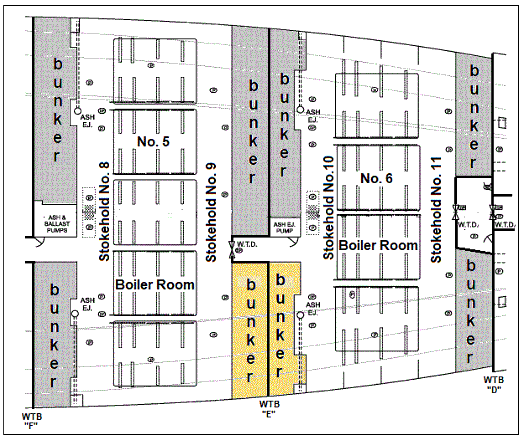
It should be noted that the total capacities of the two bunkers involved, from the tank top to G deck above, were 365 and 307 tons of coal, respectively, or a total of 672 tons. Assuming that all the coal on the starboard side of those bunkers was pulled out to feed the furnaces in both those stokeholds, by midday Sunday there could have been about 330 tons of coal remaining over on the port side in those stokeholds unless some of the remaining coal was redistributed elsewhere. Assuming 330 tons of coal was left on the port side, we can easily calculate the list that the ship would subsequently have taken on by not redistributing it.99 The result is a list of about 3° to port, assuming no corrective action was taken to reduce it.
Although there was no reported list prior to the impact with the iceberg late Sunday night, for the purpose of this study and to satisfy those who would argue otherwise, a residual list of 2° to port was assumed at the time of impact. (As it turns out, if we had assumed a 0° list, it would not have changed the resulting trendline curve by any significant amount after the first 10 minutes, by which time those emptied bunker spaces would have filled with floodwater since Leading Fireman Frederick Barrett saw hull damage to have reached across watertight bulkhead [WTB] “E” into those spaces.)
For our second data point we show Titanic with a 5° starboard list at 10 minutes following impact, or 11:50pm, as reported by QM Robert Hichens. This list was seen by Captain Smith, who came back into the wheelhouse to look at the inclinometer about 5 to 10 minutes after impact, according to Hichens. It can be shown that the 5° list to starboard was primarily caused by asymmetrical flooding in cargo Holds No. 2 and No. 3 because of the presence of the firemen’s tunnel amidships and the added free surface effect of the large volume of water that flooded into No. 6 Boiler Room.100 (See Figure 16.)

For our third data point we take the condition of the ship at 1:05am, the time that lifeboats No. 8 and No. 1 were launched in our timeline. As pointed out in Part I, it was reported by Steward Alfred Crawford that boat No. 8 did not have to be kept off the ship’s side as it was lowered down to the sea. Also, from Lookout George Symons, we were told that Titanic was still carrying a small list to starboard during the launching of boat No. 1, also put down for 1:05am. On the other hand, boat No. 6, which we showed launched about 10 minutes earlier at 12:55am, had reported problems due to the starboard list of the ship that was observed and noted at that time. In Part I we pointed out that if the ship had a list of 2° to starboard or less, a boat launched on the port side with its davits fully swung out would not touch any part of the ship’s hull if it was lowered. Therefore, from all of this, we took the list of the vessel to be about 2° to starboard at 1:05am for our third data point.
Our fourth data point came from the observation of Steward William Ward who reported that when they reached the water in boat No. 9, “she [the Titanic] was not listing at all. She was down by the head, but not listing. I could not give you any degree she was down to; a very slight angle, at that time.”101 As we shall see later on, Titanic had trimmed down by the head to about 4° by about this time, enough for Ward to notice that it was down by the head by a few degrees. Yet, Ward seemed quite adamant that Titanic “was not listing at all” at the time No. 9 was lowered. He also said that they had no problem in lowering the boat to the water. Allowing 5 to 6 minutes for boat No. 9 to reach the water, we marked 1:20am as the time the Titanic had a 0° list. This is also the same time we have for the launching of boat No. 16 over on the port side, and there were no reports of any list when that boat was launched.
For our fifth data point we took the launch time for boat No. 10, 1:50am, when the ship had assumed a 10° list to port. This was based on a gap of 2½ feet between the side of the boat and the side of the ship that was observed and reported by Seaman Frank Evans. (See the derived gap distances in Table B1 of Appendix B for various conditions of list with the davits fully swung out.)
For our sixth data point we chose the situation at 2:05am when boat D was launched. At that time the list of the ship had reached about 15° to port. This was determined from taking into account the trim that the ship took on by that time, and the reported distance that boat D had to be lowered to reach the water as related by Second Officer Lightoller and confirmed by Hugh Woolner. As will be seen in the section dealing with trim versus time, by 2:00-2:05am, during the final loading of collapsible boat D, Titanic had trimmed down by the head to over 6° causing the ship’s forecastle head to get submerged. At a 6° down angle, the level of the sea would have reached about 22 feet below the level of the boat deck as seen on the ship’s centerline (or about 3½ feet below the level of B deck on the centerline) where the collapsible boats were being launched. However, over on the port side of the ship, about 46 feet away from the ship’s centerline, water was just coming onto A deck which was only 9½ feet below the level of the boat deck. From the geometry of the situation, the angle of list needed to create what was just described is about 15° to port as shown in Figure 17 below.102
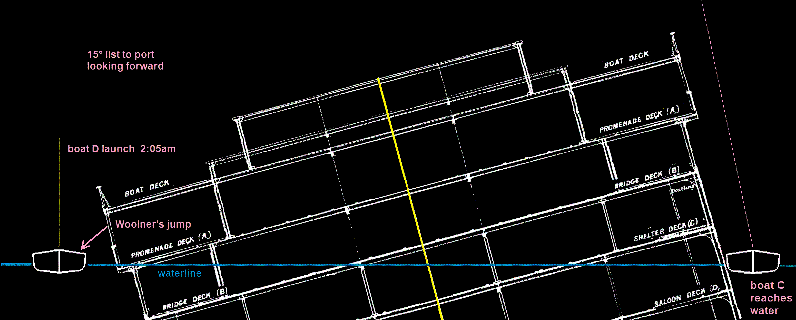
It is interesting to note, that QM Arthur Bright, who was put in charge of boat D, told Senator Smith at the American inquiry that when he left the ship, “What we call the forecastle head was just going under water. That would be about 20 feet lower than the bridge, I should say.”103 The ship’s forecastle head was at the level of B deck, just one deck higher than the level of the forward well deck.
Using an Excel spreadsheet and a 5th order polynomial regression model, we obtained the six-point trendline curve of List Vs. Time as shown in Figure 18 below.
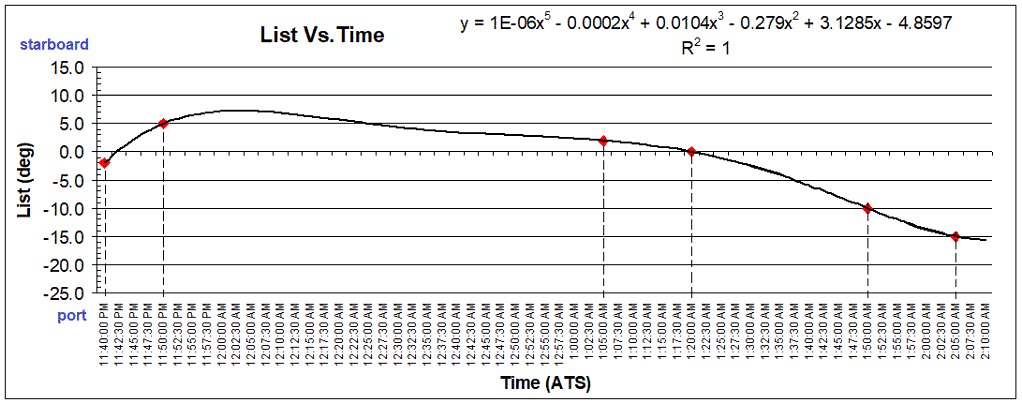
This best-fit curve was automatically obtained with the use of an Excel spreadsheet. Positive values of list represent a list to starboard, while negative values of list represent a list to port. The time scale that was used was chosen in 2½ minute increments (150 seconds) for convenience. The range in time shown is from 11:40pm, when the ship struck the iceberg, to 2:10am, when the wireless cabin was abandoned.
The next thing that was done was to place the lifeboat launch times and other related events that were developed in this study onto the trendline curve for List Vs. Time.
These results are presented below in Figure 19.

A Few Observations
From the results shown in Figure 19, we see Titanic carrying a starboard list of 2° or more during the launchings of boats No. 7, 5, 3 and 1 on the starboard side and boats No. 6 and 8 on the port side. Prior to the launching of any of the boats, a noticeable list to starboard was mentioned by several individuals during the time that the lifeboats were being prepared, and passengers were called up to go on deck with lifebelts on. We know from Lookout George Symons that the list to starboard during the launchings of the forward starboard boats worked “if anything in our favour...When we were being lowered away ourselves, we were clear of everything.” According to Mr George Harder, during the loading of boat No. 5, “I should say it [the gap between the boat and ship’s side] was about a foot and a half. Anyway, you had to jump.” (A gap of about 1½ feet could be expected with the ship having a list of 3° to 4° as noted in Table B1 of Appendix B.)104
At 12:55am, the trendline curve shows a list of about 3° to starboard. Even with the boat davits fully swung out, a boat on the port side would have a tendency to be up against the side of the ship in several places as it was being lowered. (This was shown graphically back in Figure 09 of Part I.) It would have been worse if, for some reason, the davits were less than fully swung out, and may have been the reason that QM Hichens reported that his boat, No. 6, was up against the side of the ship at the time it was being loaded from the boat deck, and had to be kept off the side as it was being lowered. (See Table B2 of Appendix B.)
By 1:05am, the list to starboard had reduced to about 2°, and a forward port-side boat such as boat No. 8, would clear the side of the ship as it was being lowered to the water at that location around that time if it was fully swung out. By about 1:00am, the ship had trimmed down by the head enough for the water to reach the level of E deck on the ship’s centerline by the location of the forward first-class stairway, something that was witnessed by Steward Joseph Wheat, as previously discussed. The location of boat No. 8 was just alongside that first-class stairway entrance on the boat deck, as was shown in Figure 06 in Part I, and the drop distance from the boat deck to the water at that place around that time would have been only about 47 feet due to the down tilt of the vessel. (Refer back to Figure 08 in Part I.)
During the launchings of boats No. 9, 16, 11 and 12 in our timeline, the trendline curve shows a list of about 1° or less to either side, which would be unnoticeable to most people.105 It is somewhat interesting to note that most of Titanic’s surviving officers said that they did not notice any list at all early on when they were questioned before the inquiries. Being seasoned officers with years of experience at sea, including many on sailing vessels where a ship healed over to one side or the other by a few degrees was the norm, small degrees of list might very well tend to go unnoticed by them.
By 1:30am, according to the trendline curve, the list of the ship had shifted over to about 2½° to port and was rapidly increasing after that. During the launching of boat No. 14, a list to port was mentioned by Steward Frank Morris, who went away in that boat,106 and by Engine Department Mess Steward Cecil Fitzpatrick, who was helping to lower the boat.107 A list to port of about 2½° would have been enough for boat No. 13 over on the starboard side to come up against the side of the ship as it neared the level of the water, about 60 feet below the level of the boat deck at that location at that time. According to Fireman George Beauchamp, he had to hold the boat away from side of the ship with an oar when it reached the water,108 something that was also confirmed by Leading Firemen Frederick Barrett, as was talked about in Part I.109
With the ship carrying about a 2½° list to port by the time No. 14 started down, the calculated gap between the side of the boat and A deck as the boat was being lowered would be about 2 feet, and between the side of the boat and B deck as it was being lowered would be about 4 feet. (See Table B1 in Appendix B.) These calculated values take into account the curvature of the ship’s hull and the overhang of the ship’s superstructure at A deck and above and assume that the davits for the boat were fully swung out when it was being lowered. By the time boat No. 14 would have reached the water, five to six minutes later, the list would have reached close to 4° to port according to the trendline curve.
It is interesting to note that Fifth Officer Lowe, who was in boat No. 14 as it was being lowered, fired two or three warning shots from his revolver between the side of the ship and the boat as it was passing decks B and C. For what it's worth when asked at the American inquiry by Senator Smith about the space between his boat and the side of the ship when he fired those shots, Lowe replied: “I really do not know. I should say - oh, 3 or 4 feet.” He then later said, “I will withdraw 4 feet and say 3 feet.” Senator Smith then asked, “You only had a space of 3 feet?” to which Lowe replied, “Oh, no. I had more. I had the width of the boat. I was standing up in the after part of her. From the center line of the boat would give another 2 feet or so. That would be 5 feet.”110
Figure 20 depicts the list on Titanic around the time that boat No. 14 would have been lowered down close to the water based on the trendline curve. By the time No. 14 would have reached the water, the list would have reached around 4° to port, as shown.

By the time boat No. 15 was launched, the list of the ship, according to our trendline curve, would have been close to 3½°. At that angle, a starboard-side boat would tend to be up against the hull in several places as it was lowered to the sea. As mentioned in Part I, a number of eyewitnesses had noticed this list to port when No. 15 was being lowered, including Fireman William Taylor, who recalled the need to keep the boat off the ship’s side as it was being lowered.111
We see from the trendline curve in Figure 19 above that the list to port became progressively worse during the launchings of the remaining lifeboats, reaching around 10° during the launching of boat #10 to as much as 15° during the launching of collapsible boat D at 2:05am, and the abandonment of the wireless cabin by Phillips and Bride around 2:10am.
Down By The Head Over Time
The question of how much did Titanic trim down by the head over time based on reported observations has been looked at before, and the results compared to the theoretical work of others. From a number of eyewitness accounts, we were able to determine the flooded state of the ship at certain times, and then map these localized observations to an angle of trim for the ship. To do that, we made use of a set of waterline curves that show the progressive flooding of the ship that were derived from the theoretical work of Hackett and Bedford.112
As the ship trimmed down by the head, the draught forward and draught aft changed over time. For any given flooded condition, the draughts forward and aft define the waterline for that flooded condition.113 We then drew a set of these waterlines against detailed profile plans of the ship such as those shown below in Figures 21 and 22. Then, if there was an eyewitness report that water was seen at some level above or below a certain deck at a particular location near the ship’s longitudinal centerline, then we know that the external waterline had to be at, or somewhat above, that particular reported level at that particular time. The trim of the ship could then be derived from interpolating between the waterline curves that bracket the observed water level at the reported location.
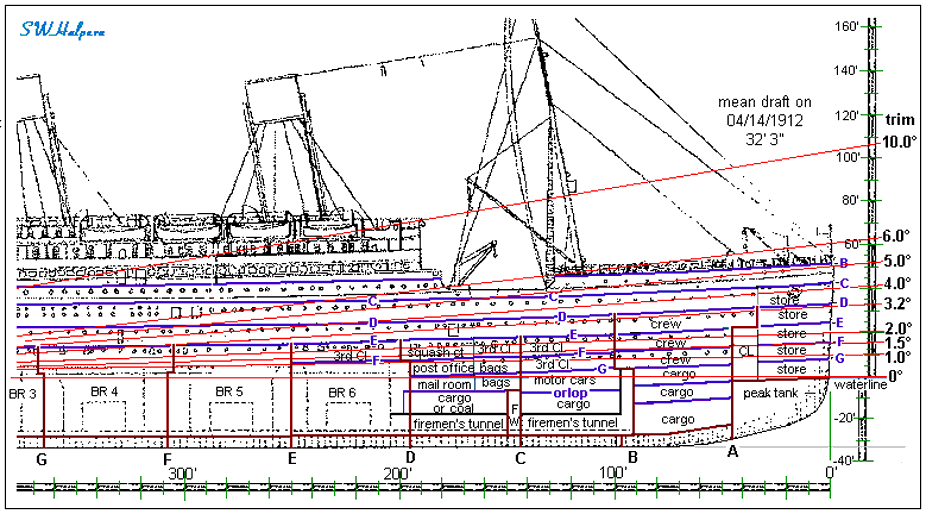
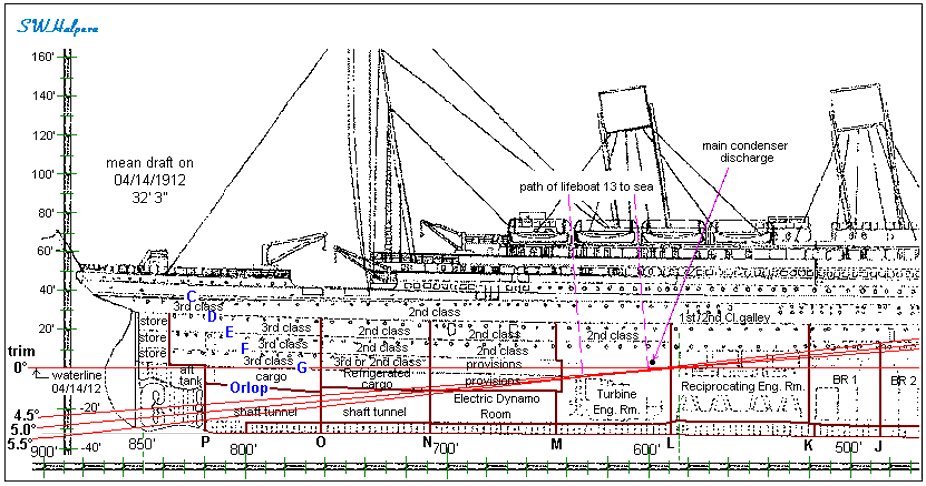
In this study, we will do what we did with regard to developing our curve of List Vs. Time by taking a few key data points and then creating a best-fit curve to obtain a curve of Trim Vs. Time. The eight data points chosen for the Trim Vs. Time curve are shown in the table below:
| Data points for Trim Vs. Time trendline curve. | ||||
| # | Event | Time | Trim | Note/Reference |
| 1 | Ship strikes iceberg. | 11:40pm | -0.2° | Intact condition Sunday night. (H&B) |
| 2 | Water at G deck by No.1 Hatch coamings. | 11:55am | 0.8° | L/O George Symons (BI 11360 & 11396) |
| 3 | Water within 6 steps of E deck by mailroom stairs. | 12:10am | 1.8° | Stwrds Annie Robinson (BI 13277-13283) |
| 4 | Water 3 ft on E deck in seamen's quarters. | 12:25am | 2.6° | AB Poingdestre (BI 2842-2858) |
| 5 | Water seen flowing down 1st class staircase from E deck. | 12:55am | 3.2° | Stwrd Joseph Wheat (BI 10956-10972) |
| 6 | Water by 2nd row of ports under ship's name at the bow. | 1:20am | 4.0° | L/O George Symons (BI 11490) |
| 7 | Well deck awash reported after Baltic contact. | 1:50am | 5.5° | W/O Harold Bride (AI p.1063, 16543-16553) |
| 8 | Water seen up to crow's nest and coming onto the forebridge. | 2:15am | 10.0° | 2/O Charles Lightoller (AI p.90) |
The intact trim condition for 11:40pm was taken from the work of Hackett and Bedford, which calculated the trim of the vessel after completing two-thirds of her maiden voyage.
The second data point was an observation by Lookout George Symons just before all hands were called out to uncover the boats, around 11:55pm. Symons was then looking down Hatch No. 1 from where he was standing on C deck under the forecastle. He saw “the water was nearly up to the coamings of the lower hatch” down on the level of G deck. (See Figure 23 below.)
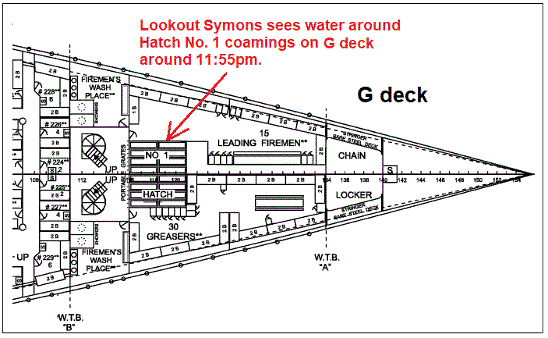
The third data point was the observation by Stewardess Annie Robinson that water was seen within the top six steps of the stairway leading down to the mailroom on E deck. Annie placed the time of that observation at about half an hour after the iceberg impact or about 12:10am. Her location is shown below in Figure 24. Considering the starboard list of the vessel at that time, for water to come with six steps of E deck at that location, the trim of the vessel had to be down by the head about 1.8°.
Our fourth data point was the observation of AB John Poingdestre about 45 minutes after the iceberg impact. At the time, he was down in the seaman’s quarters getting a pair of boots on when a wooden bulkhead separating his space from third-class passenger space collapsed, flooding his quarters. He said the water reached up to his waist as he scrambled to get out. The trim taken from the waterline curves for that location is estimated to have been 2.6°. Poingdestre’s location, about 12:25am, is also indicated in Figure 24.

Our fifth data point is the observation by Steward Joseph Wheat that water was falling down the first case staircase from E deck onto F deck around 12:55am. The resulting trim of the vessel needed for water to reach that staircase at E deck at that time was 3.2°. Wheat’s location when his observation was made was shown back in Figures 04 and 05 in Part I.
Our sixth data point is an observation by Lookout George Symons that occurred after his lifeboat (No. 1) pulled away from the ship’s side regarding the second row of ports under the forecastle head going underwater. These would be the row of ports just under C-deck. We know that boat No. 1 was launched at about 1:05am, but got hung up on the way down by a wire guy that had to be cut away. It was assumed, therefore, that it took about 10 minutes for boat No. 1 to finally reach the water and another five minutes for it to pull away far enough from the ship’s side in order for Symons to see that row of ports. This puts the time of his observation at about 1:20am. From the set of waterline curves shown in Figure 21 above, we see that ship would have been down by the head about 4° at that time, and the ship would have carried no list based on our earlier work. A sketch of the ship as it would appear off the starboard side at this time is shown in Figure 25 below.
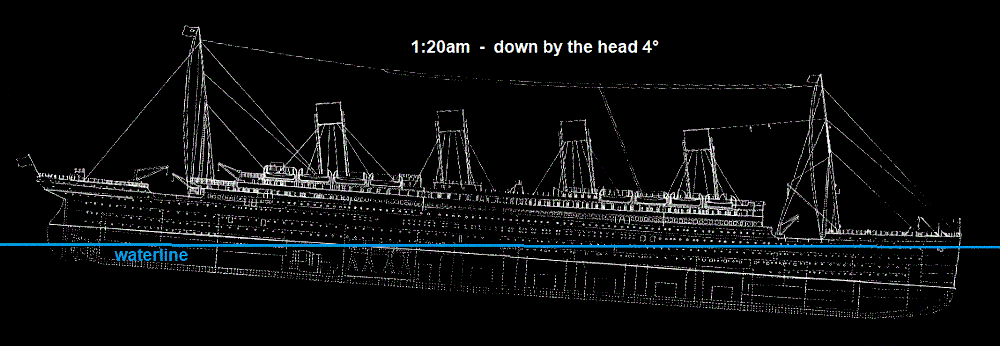
For our seventh data point, we have the observation by the senior wireless operator Jack Phillips that was reported to junior operator Harold Bride after Bride had been in contact with the steamship Baltic. In his April 27th letter to W. R. Cross, traffic manager for the Marconi Company, Harold Bride wrote:
“Mr. Phillips then went outside to see how things were progressing, and meanwhile I established communication with the Baltic, telling him we were in urgent need of assistance. This I reported to Mr. Phillips on his return, but suggested MBC [the Baltic] was too far away to be of any use. ... Mr. Phillips told me the forward well deck was under water, and we got our lifebelts out and tied on each other, after putting on additional clothing.”
Bride was questioned in some detail about this at the British inquiry:
- Did he tell you what he had found out? - Yes.
- What did he say? - He told me the forward well deck was awash.
- Did he tell you anything else? - He told me, as far as I remember, that they were putting the women and children in the boats and clearing off.
- Was anything said about a list, do you remember? - There was a heavy list to port.
- Did you notice that? - Yes.
- (The Commissioner.) You noticed that yourself? - Yes.
The time of the last contact with Baltic was at 11:47pm NY time.114 That would make it 1:49am Titanic time that the communications with Baltic were completed. We, therefore, place Phillips’ sightings around 1:50am. This is the same time that we have for the launching of lifeboat No. 10 when we showed a list to port of 10°. Taking that into account, and the waterline curves, which would be valid along the ship’s longitudinal centerline, we derived a trim condition of about 5.5° for the ship at that time.
For our eighth and final data point, we have the observation by Second Officer Charles Lightoller that at the time he abandoned the ship, “the crow’s nest was level with the water when the bridge went under water.” From the waterline curves shown in Figure 21 above, we see that that condition matches the 10° trim angle line. The time that was assigned to that event was 2:15am.
The complete Trim Vs. Time curve that was derived from eyewitness observations using a 6th-order polynomial regression model based on these eight data point is shown below in Figure 26.115 (Also shown for comparison are the data points for flooding conditions C1 through C7 from the 1996 theoretical work of Hackett and Bedford if anyone is interested.)
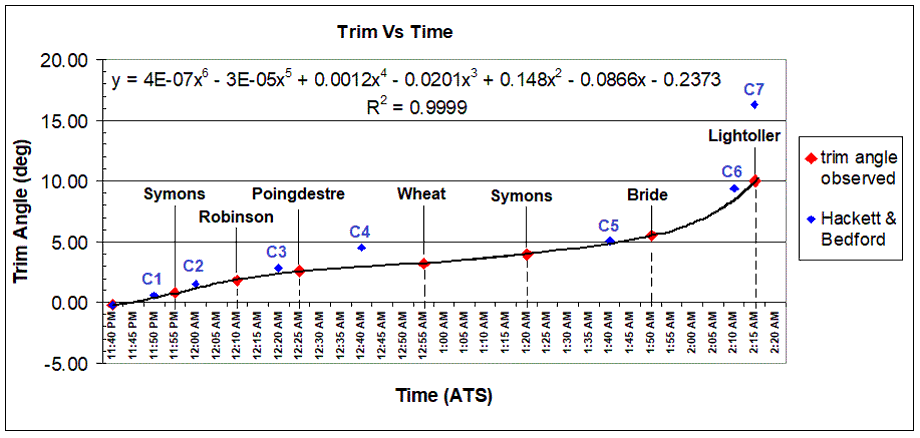
By the first half hour after the allision with the iceberg, around 12:10am, Titanic trimmed down by the head to about 2°, which was barely noticeable. In his book, The Loss of the SS Titanic, second-class passenger Lawrence Beesley wrote:
“I soon decided to go down again, and as I crossed from the starboard to the port side to go down by the vestibule door, I saw an officer climb on the last lifeboat on the port side – number 16 – and begin to throw off the cover, but I do not remember that any one paid any particular attention to him. Certainly no one thought they were preparing to man the lifeboats and embark from the ship. All this time there was no apprehension of any danger in the minds of passengers, and no one was in any condition of panic or hysteria; after all, it would have been strange if they had been, without any definite evidence of danger.
As I passed to the door to go down, I looked forward again and saw to my surprise an undoubted tilt downwards from the stern to the bows: only a slight slope, which I don't think any one had noticed, at any rate, they had not remarked on it. As I went downstairs a confirmation of this tilting forward came in something unusual about the stairs, a curious sense of something out of balance and of not being able to put one’s feet down in the right place: naturally, being tilted forward, the stairs would slope downwards at an angle and tend to throw one forward. I could not see any visible slope of the stairway: it was perceptible only by the sense of balance at this time.”
The time of Beesley’s observation was very close to midnight on Titanic, soon after the order was given to uncover the boats, and the officer that Beesley saw uncovering lifeboat No.16 was most likely Sixth Officer James Moody.
By an hour and 40 minutes after impact, 1:20am, the rate of water inflow had slowed due to the increase in pressure head of the water that had flooded into the vessel, and the tilting down of the ship had only about doubled by then to about 4°. This was enough to cover the second row of portholes under the forecastle head, as seen by Lookout Symons from lifeboat No. 1.
Assistant Saloon Steward Walter Nichols, who was rescued in lifeboat No. 15 and dedicated his story that appeared in The New York Times on April 22, 1912 to his sister, was quoted as saying:
“As soon as we got a little distance off I could see that she down a good deal by the head because the propeller was sticking half way out of the water.”
In our launch timeline, we have boat No. 15 being lowered only a few minutes after boat No. 13 was lowered. Nichols’ boat nearly came on top of boat No. 13, which had struggled to get free of the ship after reaching the water and drifted under the space that No. 15 was headed to. In all likelihood, boat No. 15 probably reached the water sometime close to 1:40am by the time No. 13 cleared away. Assuming Steward Nichols' observation took place close to 1:45am, we find from the above Trim Vs. Time curve (in Figure 26) that Titanic would have trimmed down by the head to about 5° at that time. From Figure 22 above, we can also see that the waterline curve at a 5° trim angle would expose about half the starboard-side wing propeller and also a little more than half of the ship’s central propeller as viewed from a boat off the starboard side of the ship.
Somewhere after around 1:45 to 1:50am, the rate of down tilt appears to have started to increase much more rapidly as the ship began to lose some of its longitudinal stability. By about 2:15am, the angle of trim dipped down to about 10° when Second Officer Lightoller jumped into the water as the bow took a sudden lurch forward shortly before the hull broke in two.
Summary And Conclusions
In this study we looked at several efforts to document the launching of lifeboats from the sinking Titanic. In particular, we considered the detailed work of Bill Wormstedt, Tad Fitch and George Behe (W-F-B), and the work of Ioannis Georgiou, and addressed some differences between them and pointed out a few things that may have been overlooked, misinterpreted, or not fully considered by them. This study also presented some additional considerations and insights into the question of lifeboat launch sequencing and launch times, and has put forth a somewhat revised lifeboat launch timeline based on these considerations as detailed in both Parts I and II of this work.
This study also developed curves of List Vs. Time and Trim Vs. Time using best-fit regression analysis based on some key data points. We then were able to see how the events, including the lifeboat launch times as developed in this study, fit onto those curves and saw how well those results compared to some reported observations by eyewitnesses.
Acknowledgements
I want to extend my thanks to Ioannis Georgiou and Randy Bryan Bigham for their support, some content information, and, most of all, their insights and suggestions in making this article possible.
Appendix A
The Davits and the Wreck Site
The Welin Davit
With reference to Figure A1, the pivot point (hub) of the Welin davit is at the exact center of a circle. As a crank turns the worm gear, a screw block connected to the hub travels forward or backwards on the frame while always staying at the same height. This is exactly the same as an axle of a motor carriage travels in a straight line as the wheels turn. To keep things from slipping, a rack (row of teeth) on the bottom of the davit frame meshes with teeth on the inner edge of the davit quadrant. The outer edge of the quadrant has a wider rim with no teeth. The weight of the boat acting on the davit arm forces the quadrant towards the centerline of the davit frame, ensuring the teeth always mesh and the arm stays locked in position.

From Figure A1, it is clear that in the case of a davit that is fully swung out, the hub and screw block would be located at the end of its travel on the frame, as shown on the right side of the figure. Thus, in the case of dislodged davit, such as found at a wreck, it is the position of the hub on the frame that would determine to what extent the davit was originally swung out to, not necessarily the angle of the davit arm itself.
The Davits At The Wreck – by Ioannis Georgiou
In their 2023 updated lifeboat article, the authors of the W-F-B timeline stated:
“For example, there is one cluster of lifeboat davits that landed near each-other on the ocean floor. When looking at this image, it is readily apparent that the davit arms are swung out to different degrees, even on the same davit base. This indicates that neighboring lifeboats weren’t even necessarily swung out to the same degree. Indeed, one davit arm and base was recovered and preserved by RMS Titanic Inc. The preserved davit shows that the surviving davit arm, and the base of the davit for the neighboring lifeboat, were not swung out to the same angle. Technical researchers have indicated that the worm gear would not allow the angle of the davit arms to move accidentally within the base, even during the trauma of the sinking. In other words, the positions of the davits at the wreck site are where the crewmen positioned them, over 100 years ago.”
What do we really know from the wreck about the davits? Titanic had a total of 16 pairs of davits. They were divided into 4 pairs, eight on each side, 4 forward and 4 aft.
On the forward starboard side, we still see today two davits on the wreck. One is at the forward end of boat station No. 1 and is in the position it was left there by Murdoch when he tried to get collapsible boat A ready.116 The second is at the aft end of boat station No. 7. The davit there is damaged, and the davit arm was ripped off, but the quadrant and hub show that it is in a swung-out position.117 Both these davits are still in place on the boat deck.
On the forward port side, we have the forward part of boat station No. 2 in a swung-out position. This davit is still in place on the boat deck. The aft end of boat station No. 2, as well as the forward end of boat station No. 4, had been ripped of from the deck and are resting today on the port side of the remains of the wheelhouse.118 Both davits are in a swung-out position. The next davit is the aft end of boat station No. 8. That davit was also ripped off the deck but remains close to where it was made fast. The davit arm was bent down.119 This davit is also in a swung-out position.
The stern is heavily damaged. Most part of the boat deck where the davits were had been ripped off during the plunge to the ocean floor. However, on the starboard side, one davit, that of boat station No. 15, found its resting place a few feet below what was the boat deck. Even part of the davit arm is hidden by debris, but the frame is intact, and the quadrant clearly shows that it was fully swung out.
On the port side, it is the aft end of No. 16, which is still resting on the boat deck. Also, this davit clearly shows it was fully swung out.120
Other davits were discovered in the debris field. One picture, which is called a cluster of davits,121 shows a pile of partly damaged davits. This pile is the missing set from the forward starboard side. The pile not only contains the aft end of boat station No. 1 but also the ripped-off arm of the aft end of boat station No. 7, which is still attached to the deck. Aside from davit No. 1, the others show to be swung out. Only one of them is not at the same angle as the others, which most likely is a result of the trauma from being ripped off the boat deck and landing on the seabed.
Another set of davits photographed in the debris field clearly shows them fully swung out. 122 The position of where they came from is unknown.
Another set was recovered by RMS Titanic Inc. in 1993. A photograph was taken of it before its recovery shows that it was in a fully swung-out position.123 When recovered, the davit arm swung to the other side.124 What is interesting about this one, even though it is a double-acting set, one arm is missing, indicating that it was ripped off. It is unknown from which part of the deck this came.125
In conclusion, of the 16 pairs of davits, we know the whereabouts of 12 of them. Aside from boat Station No. 1, only one pair (in total 2 arms) in the cluster of davits appear not to be in a fully swung-out position. Both of these were from the forward starboard side. This might be a result of the damage they received, as close up pictures show that they are severely damaged.
Appendix B
Determining the List From the Gap Between a Boat and the Hull
Obtaining a value of list from a reported gap between the side of a boat and the side of the ship, such as when a 2½ foot gap was reported when No. 10 was being filled, can be derived knowing the dimensions of the boat, the davits that were used, and the assumed angle (in degrees) that the davits were swung out when a boat was launched. An example of the launching of one of Titanic’s fourteen 30-foot-long lifeboats under a zero-list condition is shown below in Figure B1. It comes from a reprint from the weekly journal Engineering of July 01, 1910. (Red line markings in the diagram are from this author.)
It should be pointed out that when some of the full-sized lifeboats were first swung out early on (e.g., on the forward starboard side), the ship was carrying a noticeable list to starboard as reported by a number of eyewitnesses. It is possible that some of the starboard-side davits of those boats were swung out just enough to keep the side of the boat relatively close to the side of the ship for loading. However on the port side, with the ship carrying a list to starboard, it was likely that the port-side davits, for the most part, would be fully swung out as the boats there had a tendency to swing in close to the ship’s side when hanging freely from their davits. Such factors need to be taken into consideration in estimating a given condition of list based on any reported gap.
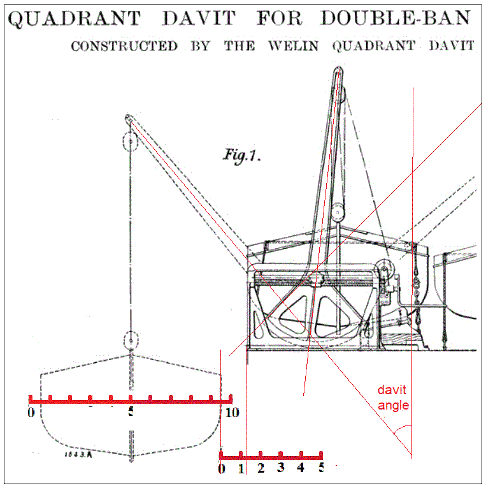
Below, in Table B-1, is a sample from a spreadsheet showing the gap (in feet) between the side of a full-sized 30-foot lifeboat and the side of the ship at the level of the Boat deck, at A deck, at B deck, and at the Waterline (WL) for various angles of list (in degrees) with the davits swung out at an angle of 40° relative to the vertical. (A positive angle of list in that table means a boat on a given side has a tendency to swing away from the ship, while a negative angle of list means a boat on a given side has a tendency to swing in toward the ship.)
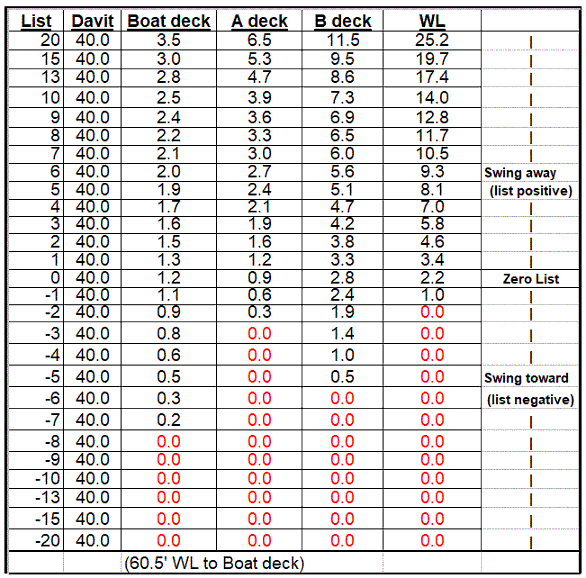
Below, in Table B-2, are gap values that were derived with the davits swung out at an angle of only 35° relative to the vertical.126
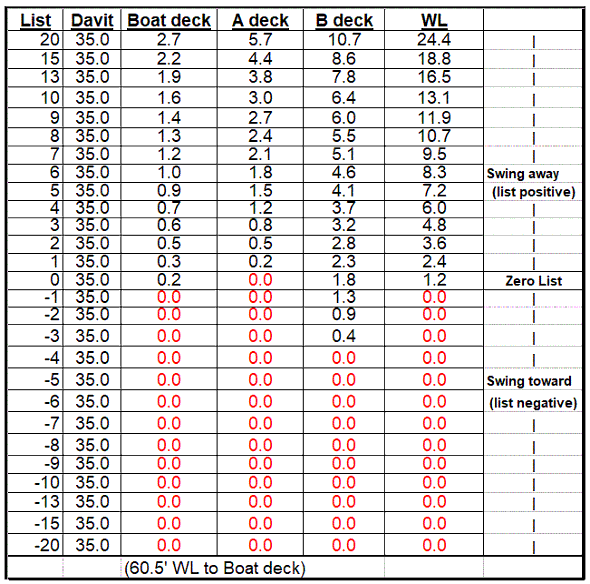

Comment and discuss